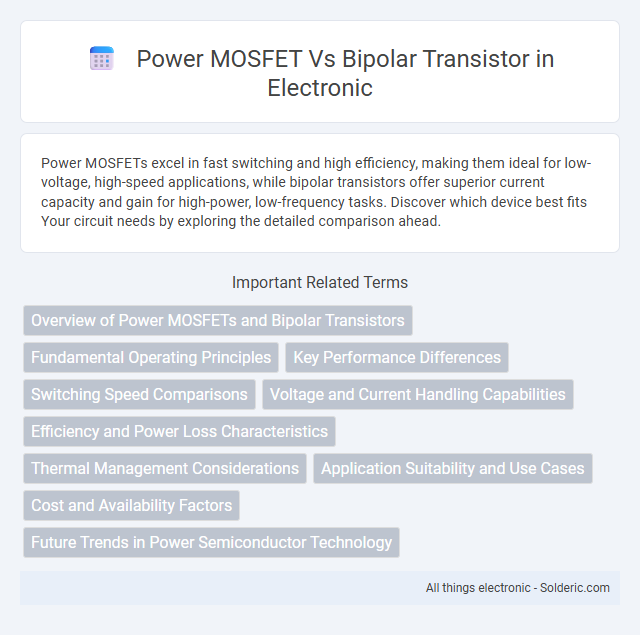Power MOSFETs excel in fast switching and high efficiency, making them ideal for low-voltage, high-speed applications, while bipolar transistors offer superior current capacity and gain for high-power, low-frequency tasks. Discover which device best fits Your circuit needs by exploring the detailed comparison ahead.
Comparison Table
| Feature | Power MOSFET | Bipolar Transistor (BJT) |
|---|---|---|
| Device Type | Voltage-controlled, unipolar | Current-controlled, bipolar |
| Switching Speed | High (nanoseconds) | Slower (microseconds) |
| Input Impedance | Very High | Low |
| Power Dissipation | Lower conduction losses | Higher conduction losses |
| Gain | No current gain (voltage controlled) | High current gain (b) |
| Thermal Stability | Better thermal stability | Prone to thermal runaway |
| Applications | Switching power supplies, motor control, RF amplifiers | Analog amplification, switching, linear regulators |
| Cost | Generally higher | Generally lower |
Overview of Power MOSFETs and Bipolar Transistors
Power MOSFETs feature voltage-driven operation with high input impedance and fast switching speeds, making them ideal for high-frequency applications and efficient power management. Bipolar transistors rely on current-driven operation with lower input impedance but provide higher gain and better performance in linear amplification tasks. Understanding the distinct electrical characteristics of Power MOSFETs and Bipolar transistors helps you select the optimal component for your power control and amplification needs.
Fundamental Operating Principles
Power MOSFETs operate by controlling voltage at the gate terminal to create a conductive channel between the drain and source, relying on majority carriers for fast switching and low gate drive power. Bipolar transistors utilize current injection at the base to modulate the flow of minority carriers between the collector and emitter, resulting in higher current gain but slower switching speeds. The unipolar conduction mechanism in MOSFETs offers better efficiency in high-frequency applications, whereas bipolar transistors excel in low-frequency, high-current scenarios due to their higher transconductance.
Key Performance Differences
Power MOSFETs exhibit faster switching speeds and higher efficiency compared to bipolar transistors, making them ideal for high-frequency applications. Bipolar transistors typically offer greater current handling capability and better performance at low voltages due to their lower on-state voltage drop. Your choice between the two depends on the specific requirements of switching speed, power dissipation, and voltage levels in the circuit design.
Switching Speed Comparisons
Power MOSFETs exhibit significantly faster switching speeds compared to bipolar transistors due to their majority carrier conduction mechanism, resulting in lower switching losses and reduced delay times. Bipolar transistors rely on minority carrier injection, causing slower turn-off times and higher storage charge, which limits their switching frequency and efficiency in high-speed applications. Consequently, Power MOSFETs are preferred in switching power supplies, motor drives, and RF amplifiers where rapid switching performance is critical.
Voltage and Current Handling Capabilities
Power MOSFETs excel in high-voltage applications, typically handling voltages from 20V up to 1000V or more, making them ideal for switching and amplification tasks in power electronics. Bipolar transistors can manage higher current densities due to their low saturation voltage, supporting currents well above tens of amperes, which is advantageous in high-current circuits. MOSFETs offer faster switching speeds with lower gate drive power, while bipolar transistors provide robust conduction with less on-state voltage drop, affecting their efficiency in different voltage and current scenarios.
Efficiency and Power Loss Characteristics
Power MOSFETs exhibit higher efficiency and lower power loss compared to bipolar transistors due to their majority carrier conduction and negligible gate current, resulting in faster switching and reduced conduction losses. Bipolar transistors suffer from higher saturation voltage and significant charge storage effects, leading to increased switching losses and lower overall efficiency in high-frequency applications. Consequently, power MOSFETs are preferred in designs demanding minimal power dissipation and improved thermal performance.
Thermal Management Considerations
Power MOSFETs exhibit lower on-resistance and faster switching speeds, resulting in reduced heat generation compared to bipolar transistors, which experience higher power dissipation due to their voltage drop and slower switching. Effective thermal management for bipolar transistors requires more robust heat sinks and possibly active cooling to maintain reliable operation under high current loads. Your choice between these devices should consider the thermal design constraints of your application to optimize performance and longevity.
Application Suitability and Use Cases
Power MOSFETs excel in high-speed switching applications like DC-DC converters and motor controllers due to their low gate charge and fast switching times. Bipolar transistors are preferred in high-current, high-voltage linear amplification tasks such as audio amplifiers and power regulation because of their superior current gain and thermal stability. Your choice depends on whether switching efficiency or linear amplification performance is the priority in the specific electronic system.
Cost and Availability Factors
Power MOSFETs generally offer lower manufacturing costs and higher availability due to widespread demand in switching applications and mass production efficiencies. Bipolar transistors tend to be more expensive and less readily available as they are used in niche analog and high-current applications. Your choice between these devices should consider budget constraints alongside availability to ensure cost-effective and timely procurement.
Future Trends in Power Semiconductor Technology
Power MOSFETs are expected to dominate future power semiconductor technology due to their faster switching speeds, higher efficiency, and lower on-resistance compared to bipolar transistors. Emerging trends emphasize wide bandgap materials like SiC and GaN, which enhance power MOSFET performance for high-frequency and high-temperature applications. Your choice of device will increasingly rely on these advances to achieve superior energy efficiency and miniaturization in next-generation power electronics.
Power MOSFET vs Bipolar transistor Infographic

 solderic.com
solderic.com